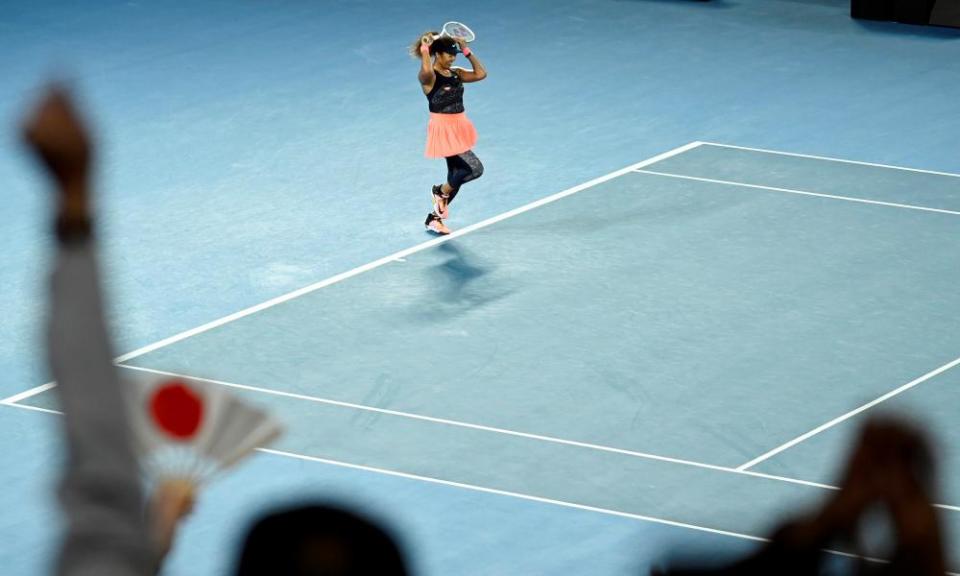Naomi Osaka jigs and punches her way to glory and tennis legend status

As a coral sun set behind the Melbourne skyline, Naomi Osaka walked to her mark, danced lightly on the balls of her feet, rapped her left thigh with her left fist two times and crouched, ready to receive Jennifer Brady’s serve. She did this over and over: jig, tap, dip; jig, tap, dip. It was a meditation that secured a second Australian Open title and a fourth grand slam for the dominant force in women’s tennis.
Both finalists powered through the draw behind dominant first serves, but an unexpectedly cool and blustery evening proved disruptive. The wind was not strong but it was capricious, darting around the Rod Laver Arena, spooking the contenders at their moment of focus. Neither player averaged more than 45% of their first serves during an opening set littered with apologetic waves for errant ball tosses.
Related: Naomi Osaka overpowers Brady to win second Australian Open title
The third seed had to find another way to earn points so she bullied them off Brady, taking returns early, firing them deep to her opponent’s toes and using that platform to dominate the court. “I felt rushed, like she was applying pressure,” Brady said. Time and again Osaka returned to the baseline, raised her calves, punched her quads and took care of business.
When she was a 15-year-old phenomenon, Osaka said her favourite shots were her forehand and serve “because I feel like I can end the point any time I want”.
Ordinarily that is the case. It was against Serena Williams in the semi-finals, and especially so in closing out the fourth-round match against Garbiñe Muguruza that was rarely on her racket. Here she did not have that luxury but demonstrated not everything has to be in her favour to prevail.
“She played really well when she had to,” Brady said. “She hit good shots when she needed them. And in those moments that’s the toughest time to find those shots.”
Since the start of 2017, when Williams collected her 23rd major title, there have been 12 winners of the 16 slams on offer. During that period only two players have won multiple slams: Simona Halep with two and Osaka with four. She has filled a void, becoming the first player since Maria Sharapova in 2012 to reach that tally. It is her fourth season in a row with a major title. “She’s just a boss,” her boyfriend, the US rapper Cordae, told GQ recently. “She’s a killer.”

This was the first of Osaka’s slams to arrive after entering the final an overwhelming favourite. As with every challenge in her career it was one she scaled with aplomb.
“I fight the hardest in the finals,” she said after vanquishing her idol in the semis. “That’s where you set yourself apart.”
It is competitive instinct straight out of the Kobe Bryant playbook, a mentor she has called an older brother and an uncle.
Related: What next for Serena Williams after her tearful Australian Open exit? | Tumaini Carayol
Such insatiable drive still feels at odds with Osaka’s off-court personality, which remains disarmingly adorable; the 23-year-old wears her greatness lightly. But as Jayne Hrdlicka, chair of Tennis Australia, said during the presentation of the Daphne Akhurst Memorial Cup: “In the last 12 months, you have stepped into your voice.”
This was in reference to Osaka’s powerful mask-wearing statement at the US Open and her growing willingness to engage in public debate on sensitive issues including violence towards Asian Americans and the resignation of Yoshiro Mori as president of the Tokyo Olympics organising committee.
“You’ve made a huge difference in everything you focussed on and it is truly inspiring and an opportunity for all of us to step back and look at the ways we can make a difference in the community,” added Hrdlicka.
The first Australian Open trophy Osaka won, in 2019, resides on a plinth in the corner of her living room. One of her US Open trophies is nearby, closer to the television. She might need to follow in more of Williams’s footsteps soon and construct an entire room dedicated to silverware. This will not be the last shiny cup engraved with Osaka’s name.
In that teenage interview, Osaka said, with the same understated sotto voce she used on the podium in Melbourne: “My goal is to become a tennis legend. I will do anything in my power to get there.”
Mission accomplished.

 Yahoo Sport
Yahoo Sport 





































